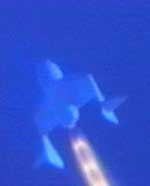
Image credit: Scaled Composites
The weather was cooperating perfectly in Mojave this morning, as the White Knight carrier airplane lifted off from the runway, cheered on by thousands of space enthusiasts. White Knight circled the airport, steadily rising until it reached an altitude of 15,250 metres (50,000 feet).
And then, at 7:50 am PDT SS1 was released and test pilot Mike Melvill ignited the rubber and nitrous oxide engine and blasted straight up into the sky, experiencing more than 5Gs for just over a minute. Just a few minutes later ground-based radar from several sources confirmed that SS1 had become the first privately built vehicle to reach space.
First a pilot, and now an astronaut, Melvill put SS1’s wings into a position that would guide it into the right trajectory to glide right back where the journey began just an hour earlier: Mojave Airport in California. The return journey took just 25 minutes, and SS1 landed safely.
Although SpaceShipOne reached space today, it wasn’t a qualification flight for the Ansari X Prize, which awards $10 million for the first privately built spacecraft that can carry 3 people to space twice in 2 weeks. On this flight, SS1 only carried the pilot, and it wasn’t officially registered with the X Prize, which requires a month’s notice.
Designer Burt Rutan allayed any fears that it couldn’t make altitude with 3 people, however, warning that Melvill needed to turn the rocket engine off at the right time or he’d be flying to 130 km. Initial reports indicated that this wasn’t necessary on the flight; that the engine might have turned itself off early.
With the success of SS1, official X Prize flights will probably take place before the end of summer. Unless another competitor emerges out of nowhere, SS1 is expected to take the $10 million.
SpaceShipOne has been in development for more than 8 years, even before designer Rutan heard about the X Prize. But for the past few years, billionaire Paul Allen is believed to have invested more than $20 million to get to this point.
